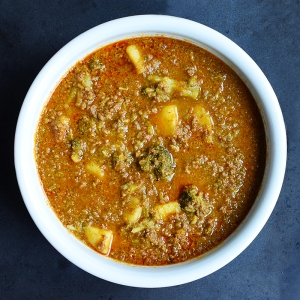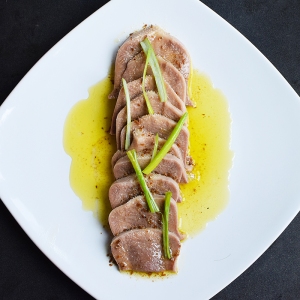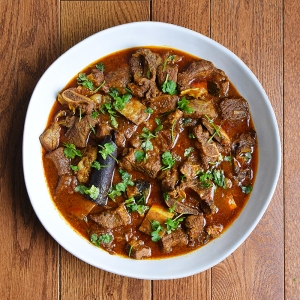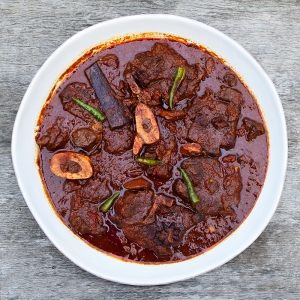
For someone who did not grow up eating oxtail—I think I had it once before I left India and very rarely in my first decade in the US—I do love it now in curries. It’s a perfect cut of beef for slow-cooked curries in particular. The meat becomes wonderfully tender as the bones and gelatin give depth of texture and flavour as they meld with the spices in the curry. If you can’t find oxtail near you—we get ours directly from a south Minnesota farm, but it’s also available in Middle Eastern and Korean groceries in the Twin Cities—you can use short rib or even brisket or cut up chuck. If using a boneless cut suitable for slow-cooking, you should reduce the meat to 2 lbs and add 1 lb of soup bones (ideally with marrow) for that extra oomph. The other essential ingredient here is kalpasi/dagad phool, a lichen that is essential in Chettinad cooking, and which thankfully is now available easily in desi stores in the US, and also online. Speaking of Chettinad cooking, I’m not following any specific Chettinad recipe here, which is why I call this a Chettinad’ish curry. Give it a go anyway! Continue reading
Tag Archives: beef
Kofta Curry with Green Peppers

This may be a recipe for kofta or meatball curry but really, it too had its origins in trying desperately to use up my vegetable garden bounty. The curry was made with a lot of tomato and with green Carmen peppers that had not yet turned/begun to ripen before the first killing frost a week ago. Carmen peppers turn a lovely scarlet colour when fully ripe but are also quite sweet and very tasty when green. The koftas were made here with ground beef (from Goette Farms) but you can use ground lamb or goat or even turkey (keema and koftas being the best ways for turkey to shine in the Indian kitchen in my experience). The large amount of tomato used makes the curry quite tangy and the flavour of the green peppers matches it well. It’s a pretty quick and simple preparation—largely because I don’t bother frying the koftas first—and rather tasty. Continue reading
Keema Curry with Broccoli

Growing up, keema was always minced mutton or goat meat. It was cooked in our house both as loose keema and as kofta (meatball) curry and it’s hard to say which I preferred. When I first came to the US goat keema was not easy to find. Indeed, it’s not easy even now without going to the few desi stores that sell meat or to stores catering to other goat eating cultures. But beef keema/ground beef is pretty good too in these preps. If you can find grass-fed beef keema then all the better—that gamy tang takes it pretty close to goat/mutton. And while I don’t have much use for turkey meat in Indian preps, I find ground turkey works well for keema—as long as it isn’t all white meat. And it works particularly well In a robustly spiced dish like this one where broccoli additionally adds an earthy quality. Still, in the absence of goat/mutton keema, beef would be my top choice. The point is that you can use whatever you have at hand. What you will end up with will be comfort food of the highest order and the broccoli will help you feel virtuous. Continue reading
Tongue, Two Ways

Keep calm: all I’m offering you is two ways of preparing beef or ox tongue, one as a lightly-dressed warm salad and the other masala-coated and crisply fried. The second is an extension of the first and given the size of the average ox tongue you’d be a fool to not make both. Now, you might say to yourself, “tongue—how Indian is that?” Well, tongue is indeed eaten in many parts of India; indeed, one of our kids’ absolute favourite dishes on our trip to India in 2020 was fried tongue, which we ate at a couple of restaurants in Goa. And the fried version I present here is my attempt to recreate those preps from taste memory. The first preparation—as a dressed warm salad—may not strike you as obviously Indian; and it is true, I’m not aware of any traditional preparation in this general vein (which is not to say that one might not exist). But as far as I’m concerned it’s an Indian dish through and through. The tongue is prepared by simmering it with whole garam masala and then sliced thinly and dressed with a vinaigrette in which roasted cumin has been steeped. Both versions go very well with dal and rice. Continue reading
Beef Curry

Another week, another beef curry. I made this slow-cooked curry the week before I left for Delhi (where I will be for another week) and the family instructed me in no uncertain terms to immediately write down exactly how I made it so that I can make it again. I think I may have mentioned before that when not cooking expressly for the blog I rarely make the same thing twice in the same way—mostly because, like most home cooks, I eyeball ingredients and don’t really care very much if one time there’s less cumin or more coriander seed in the masala than on another occasion. In fact, this kind of improvization has led to some of the dishes we like the most, as is the case with this curry. I made it with short ribs from the excellent Goette Farms in southern Minnesota. It was a large pack of ribs—4 lbs total—and I expected that we’d eat half of the curry and freeze the rest for later. But the boys loved it so much that it was all gone within 48 hours. I can’t guarantee that you’ll like it as much as they did but I’d be shocked if you didn’t like it at all. Give it a go. Continue reading
Beef Curry with Red Wine

I improvised this beef curry back in December. I’d thawed a pack of what had been labeled soup bones by the meat locker through which we’d bought a quarter of a cow a while ago. The plan had been to make pho. But when I opened the packet they turned out instead to be highly meaty shanks. I pivoted to making a slow-cooked curry and decided to take this opportunity to also finally use up an open bottle of red wine that had been sitting in the fridge for god knows how long. Meat, spices, a long braise on low heat: what could go wrong. Absolutely nothing, you’re thinking, and you’re absolutely right. Nothing did go wrong. In fact, things went very, very right. And here is the recipe to prove it. Please keep in mind that even though the recipe makes it look like a fixed thing this was—as with almost all my cooking—made on the fly. Feel free to play with the proportions of spice and ratios of tomato, red wine and water. There happened to be roughly two cups of wine left in the bottle but I would have added whatever had been in there. Who’s to say it wouldn’t have been ever better if braised entirely in wine? If you do tinker let me know how it goes. Continue reading
Indo-nesian Beef Curry

I’ve mentioned before that in the pre-pandemic times (you may or may not remember them) I had been hosting bi-monthly dinners for eight in our town that I call India’s Gandhi Tandoori Bollywood Mahal. I was getting ready for the 15th iteration when the first lockdown hit. These were 5-7 course meals, a mix of dishes traditional and less traditional. The fourth of these dinners featured an improvized beef curry that I called Indo-nesian beef curry. I’d started out making a slow-braised curry with South Indian accents and then decided to hit it with some Southeast Asian touches. The results were excellent—an intersection between Indonesian rendang and beef curry from some place between Kerala and Chettinad. There was only one problem—the dish had been improvized from beginning to end and in the rush of dinner prep I hadn’t taken any notes whatsoever. I’ve long planned to try and recreate it but until a few weeks ago I never got around to it. Well, it’s hard to say for sure after almost three years but I think this comes pretty close. It’s very tasty at any rate. I’ve made it with beef on both occasions but it would probably be just as good with goat or lamb and probably also very easily adapted with chicken. Give it a go and see what you think. Continue reading
Oxtail Curry

Oxtails are at a premium in our home. Korean-style oxtail soup as made by the missus is one of the boys’ absolute favourite foods and so any oxtail we purchase almost always goes into making that. Alas, good oxtail is not always easy to find. In December, however, I connected with a small farm in the far south of Minnesota that sells their beef and lamb both directly from their website and from a trailer they bring up north once a month and park in a lot, usually in Burnsville. As it happens their route takes them right past the exit on Highway 35 to our town and so I made a date to meet them in the parking lot of the Flying J gas station (aka The Big Steer). The tryst was originally going to be for the purpose of purchasing lamb shanks. I asked if they had oxtails as well and they said they did. I took their entire inventory (less dramatic than it sounds: they had five left). With that many in the freezer at once, and the promise of a re-supply when done, I was able to claim two for my own uses. Continue reading
Keema with Peppers and Potatoes

The word “keema” refers to both the ingredient—ground or minced meat—and to the stew-like dishes—not a million miles from chili—that are often made with it. In India the most common kind of keema by far is that of mutton or goat. In the US where goat/mutton is not as easily found I mostly use ground beef—though ground turkey does well in these preps too. In fact, I would say that it is in this kind of preparation that beef comes closest to substituting for goat in Indian cooking. That’s just my opinion, of course, and it shouldn’t be taken as implying that beef doesn’t have a place of its own in Indian foodways. No matter what the Hindu fundamentalist dispensation that is well into the process of destroying what remains of India’s secular fabric will tell you, beef is an Indian ingredient too. Continue reading
Spice-Crusted Tip Roast

We go in with friends on half a cow/steer each year but this year we doubled our take. Rather than all of us take 1/8 each as we usually do, our household took a quarter and the others took 1/12th each. I’m sorry for beginning this post about food with advanced mathematics. The point is we have rather a lot more beef in our freezer than we usually do. It’s good beef, so having a lot of it is not a problem in and of itself. The cattle are raised locally, without any hormones or antibiotics, they roam freely but are not entirely grass-fed. When it comes time for slaughter they are taken to a local meat-processing facility/butcher’s and we place our cut order. This is not a fancy artisanal butcher and most of the cuts available are standard-issue: we get flank and skirt, for instance, but not flat iron or hanger. This is not a problem either. The problem is that when you have a quarter of a large cow or steer in your freezer you need to come up with many ways of cooking it for, no matter how delicious they are, if only a few recipes comprise your repertoire, monotony must follow, as the night the day or as hateful inanity follows the opening of Donald Trump’s mouth. Continue reading
Meatball Curry, Kerala Style

This recipe is taken from one of my very favourite Indian cookbooks, Mrs. K.M. Mathew’s Flavours of the Spice Coast. A classic, published in 2002 by Penguin India, though written/compiled over a long period of time before that, it contains a large number of recipes, non-vegetarian and vegetarian, from Kerala. I regard it with the same kind of affection I have for my copy of Marcella Hazan’s Essentials of Classic Italian Cooking, and it is the only other cookbook on my shelves that I’ve thumbed through as often. That’s not to say that the two books are equivalent. For one thing, Flavours of the Spice Coast is not quite as comprehensive in its coverage of recipes. For another, it contains far less additional information on the recipes themselves (unlike in Vijayan’s The Essential Kerala Cookbook, you will not be told which community a particular recipe comes from). And finally, the recipes are not always terribly precise—you will sometimes get the feeling that a step or two might have been omitted or misheard in the transcription. Here’s the kicker though: every recipe I’ve made from this book has been dynamite. Buy it now, before going on to read the rest of this post; you won’t regret it. Continue reading
Steak Two Ways, Indian and Korean

It’s summer, we bought a quarter of a cow, and so we’re grilling a lot of steak. Sometimes just with salt and pepper, often with some improvized rub of Indian spices, occasionally marinated a la Korean kalbi. A note on the last: kalbi/galbi refers to a particular cut of short rib. However, the butcher who processes the beef we buy doesn’t do that cut; and the Korean stores in the Twin Cities sell less than optimal versions for very high prices. So, even though my wife doesn’t like the idea very much we’ve been doing it of late with other cuts of meat (in this case sirloin). And for the Indian part, I’ve noted before that far more beef is eaten in India than most people (including most Indians) realize, but we don’t really have a tradition of grilled steak. Most beef preparations are braises of one kind or the other. So, when you see me post recipes for steak with Indian flavours that’s just me substituting Indian ingredients in marinades and rubs. I’ve previously posted a recipe for flank steak—that was a wet marinade, this one is a dry rub. Continue reading
Keema Posole

Here is the third recipe from my first outing with a bag of Rancho Gordo hominy. I actually made this alongside the palak posole and before the pozole rojo—I note this for the benefit of my future biographers. Unlike the palak posole, where the hominy was replacing paneer (two things that are nothing alike), this recipe is not a stretch. I am not alone in putting sweet corn kernels in my keema as a matter of course. Of course, hominy does not taste like sweet corn and you might say that in this recipe it actually replaces diced potato: working both as an extender and as a textural contrast to the ground meat (keema). If you don’t have hominy on hand just dice two large potatoes. But if you do have hominy on hand or are looking for more uses for it, give this a go. Whichever way you make it, it’s very simple. Continue reading
Flank Steak with Indian Spices

Here’s a quick recipe for very tasty grilled flank steak. It’s an adaptation of this recipe on Epicurious (originally from a 1995 issue of Bon Appetit). I’ve kept all the wet ingredients and only swapped out the dried herbs and added some spices to give it a subtle Indian flavour. It’s very easy to pull the marinade together, and the marinade is so delicious I’m going to use it in the future for pork and chicken as well. You could probably use it for other cuts of beef too, but it works really well with flank because it cooks so fast on the grill. Otherwise, given the amount of sugar in the marinade it’s likely to burn completely (even with the quick sear it chars quite easily). I made it today for a small gathering focused on the carving of Halloween pumpkins for kids and it was a big hit. Continue reading
Pot Roast with Indian Spices

There’s a lot of ahistorical nonsense going on right now in India about the eating of beef (see here for the latest outrage and here for some context) and so you can consider this a political recipe.
It represents a melding of American/European technique with Indian flavours. Though Indians (and other South Asians) do roast and braise larger cuts of meat, there is nothing traditional about this recipe: it is improvised by me. It takes the usual American approach to beef roasts—season the meat, sear it and then braise it with liquid and aromatics in an oven or on the stove—and merely switches the seasoning and aromatics. It might look like fusion but if I were to cut the beef into cubes and do everything else more or less the same way it would look like a very unremarkable “curry”. Anyway, you can do this with larger cuts of lamb and mutton (goat) too, though you might have to adjust the cooking time. And you could also do it in the slow cooker as well, though in that case you might need to use less liquid. Continue reading
Spicy, Shredded Beef

This is cooked with Indian spices but there is nothing traditional about this dish, nor does it originate in any particular region. I improvised the general approach some years ago for pork shoulder in the slow cooker (though I use a slightly different spice mix for pork). You cook it low and slow all day long, take the meat out when done and shred it with a fork and mix it in with the sauce. The end result is very close to the Mexican barbacoa in looks but, of course, tastes quite different. You can eat it in much the same way: with rice, or with chapatis or parathas (rolled up in them or otherwise). I suppose if you really wanted to get fusiony you could even put it in a sandwich.
But whether making a sandwich or an ersatz taco/burrito I find it difficult to add cheese. This is entirely my problem. Despite all the similarities between Mexican and Indian cuisines—both in terms of form and flavour—I can’t wrap my head around putting cheese over Indian meat dishes (or any other dishes for that matter). Those not bound by a lifetime of associations should feel free to experiment that way and report back. Continue reading
Spiced Meat Tart

I’m not much of a baker and I’m also usually not much for things like celebrating “Pi Day” with pie. However, when we were invited to a “Pi/Pie Day” potluck this weekend there was no way I was going to pass up the opportunity to eat some of the pies and tarts from a bunch of complete ringers among the other guests, a couple of them professionals in all but name. Of course, this meant I had to bake a pie too.
Despite my new-found proficiency with rolling chapatis and parathas, pie dough freaks me out completely and so this led to much paralysis as I canvassed everyone I could think of for ideas for idiot-proof dough (the filling I was not worried about). Finally, I settled on using the galette dough from the excellent Baking with Julia book (the recipe is by Flo Braker and is available here). I’ve made galettes using that dough (galettes don’t require precision rolling) and so figured I would be able to handle it. Things didn’t go quite as smoothly as I”d hoped on the dough/crust front (for details on which see the captions in the slideshow below). However, the filling came together very nicely: I improvised a spiced meat filling using ground beef from the portion of the cow we bought last month, Indian spices, raisins and dried cherries. Continue reading
